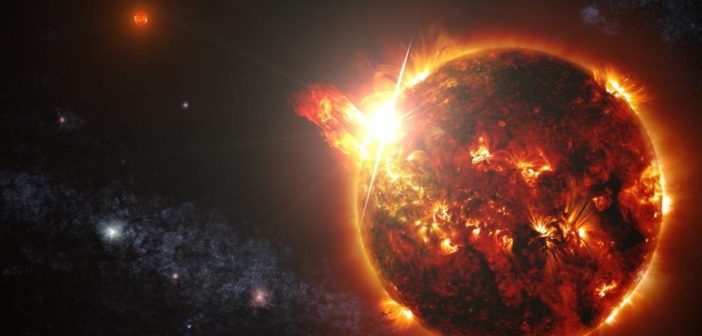Editor’s note: Astrobites is a graduate-student-run organization that digests astrophysical literature for undergraduate students. As part of the partnership between the AAS and astrobites, we occasionally repost astrobites content here at AAS Nova. We hope you enjoy this post from astrobites; the original can be viewed at astrobites.org.
Title: The Surface UV Environment on Planets Orbiting M-Dwarfs: Implications for Prebiotic Chemistry & Need for Experimental Follow-up
Author: Sukrit Ranjan, Robin Wordsworth, & Dimitar D. Sasselov
First Author’s Institution: Harvard-Smithsonian Center for Astrophysics
Status: Published in ApJ
Note: The reference to “life” in this post refers to “life as we know it here on Earth.”
M dwarfs, the smallest and coolest (in temperature and by reputation) of the main sequence stars, are also the most abundant type in our galaxy. As this Astrobite post notes, Earth-sized and super-Earth sized planets are also quite common around these stars, with 0.86 of these types of planets per M dwarf. Also, as M dwarfs are cooler, their habitable zone is located much closer in — and the consequent shorter periods of M dwarfs’ habitable-zone planets makes it easier to observe multiple transits. Therefore, if we want to search for a habitable planet, then we should be looking for it around an M-dwarf. Several habitable-zone planets have already been discovered around M-dwarfs; Trappist-1 has 3 of them!
Unfortunately, just because a planet is in the habitable zone doesn’t necessarily mean that it can support life. M dwarfs produce a lot of ultraviolet (UV) light, especially at the shorter UV wavelengths (extreme UV or EUV). Not only does UV light give you a sunburn, it can wreak havoc on life, from destroying cells to stripping a planet of its water and atmosphere. Most studies agree UV is bad for business and there is a high probability that M-dwarf planets can’t support life as we know it.
The authors of today’s paper shine a new light (pun intended) on the effect of UV on life. They note that previous laboratory studies have discovered that UV light is actually necessary to create the building blocks required for life, such as RNA, amino acids, and sugars. The creation of these building blocks is also known as prebiotic photochemistry. Could M-dwarf UV radiation actually be fueling life instead of destroying it?
Early Earth Around an M Dwarf

Figure 1: Spectra of multiple types of M dwarfs and the approximate spectra of the 3.9-billion-year-old young Sun in black. Top panel is the total amount of flux the stars create at varying wavelengths. At shorter ultraviolet wavelengths, both M dwarfs and the young Sun radiate a comparable amount of flux. Bottom panel is the amount of light that reaches the surface of the early Earth. The cutoff at 200 nm is due to absorption by carbon dioxide in the atmosphere. A significant amount of UV light from the young Sun reaches the planet surface compared to any of the M dwarfs. [Ranjan et al. 2017]
Can Life Develop or Not?
This doesn’t necessarily mean that life as we know it couldn’t have developed on a M-dwarf planet, just that the pathways to achieving prebiotic chemistry would take substantially longer (on order of 1010 years or almost the current age of the universe). If this is the case, then there hasn’t been enough time for life on most M-dwarf planets to develop! However, if the reactions take too long, the paper points out that other chemistry might dominate that which is needed for life, though it is unclear what the timescale for its development would be.
But there may be a way around this. M dwarfs are fairly active and are known to flare often. The authors repeat their experiment using the spectrum of a known flare from the M dwarf AD Leo. They find that for a short period of time, the planet experiences UV flux that is 10x that of the Earth for some wavelengths, leading to reaction rates which are up to 10x as fast. A comparison of reaction rates before and after a flare is shown in Figure 2. The Relative Dose Rate corresponds to reaction rates. The different colored boxes in Figure 2 represent different chemical reactions. Before a flare, AD Leo, a fairly active M dwarf, drives reaction rates that are slower than those driven by an early-Sun host star. But during a high-energy flare, its reaction rates jump orders of magnitude!

Figure 2: Reaction rates (Relative Dose Rate) of the young Sun, AD Leo when it is not flaring (i.e., it is quiescent), and AD Leo when it does flare. Each colored box represents different prebiotic photochemical reactions. [Adapted from Ranjan et al. 2017]
As to whether UV radiation is good or bad, we keep coming up with the same answer: “we don’t know.” It turns out we continue to prove a very obvious conclusion: life and the development of life is really complicated.
About the author, Jessica Roberts:
I am a graduate student at the University of Colorado, Boulder, where I study extra-solar planets. My research is currently focused on understanding the atmospheres of the extremely low-mass low-density super-puffs. Out of the office, you will probably find me running, cross-stitching, or playing with my dog.


1 Comment
Pingback: AAS Nova – New